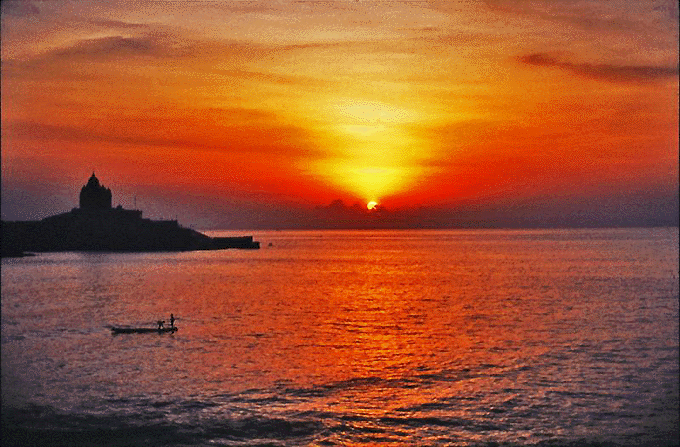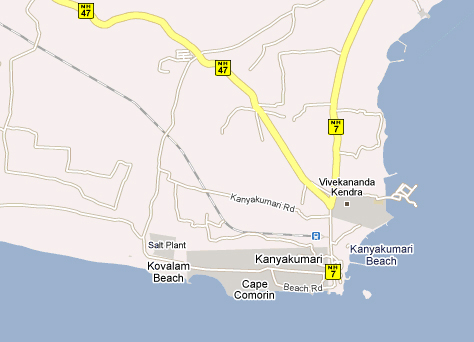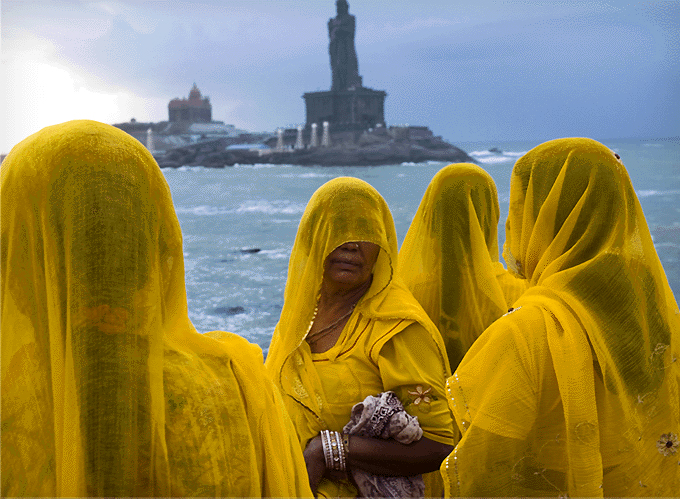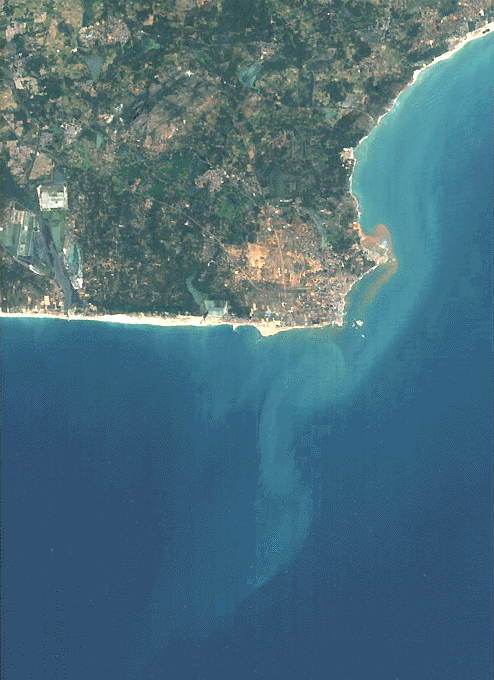
|
|
|
|
BY: SUN STAFF

Cape Comorin Feb 17, CANADA (SUN) — A serial exploration of the holy sites visited by Lord Caitanya. Kanya-kumari
In Sri Caitanya-caritamrta Madhya Lila, the summary narration of Lord Caitanya's travels includes His visit to Kanya-kumari, a tirtha at the southernmost tip of the Indian subcontinent. Mahaprabhu visited this place, also known as Cape Comorin, just before His pastime with the Bhattatharis.
Kanya-kumari is positioned at the point where the Bay of Bengal, the Indian Ocean, and the Arabian Sea meet. The tirtha is marked by two rocks half submerged in the sea, known as Pitru-tirtha and Matru-tirtha. Many people come to bathe at Kumari Ghat, right on the tip of the Cape. Madhya 9 Summary "The Lord next visited the places known as Pandya-desa, Tamraparni, Naya-tripadi, Ciyadatala, Tila-kanci, Gajendra-moksana, Panagadi, Camtapura, Sri Vaikuntha, Malaya-parvata and Kanya-kumari. The Lord then met the Bhattatharis at Mallara-desa and saved Kala Krsnadasa from their clutches." Later in Madhya 9, Srila Prabhupada offers some interesting details in his purport: Madhya 9.223
"Sri Caitanya Mahaprabhu then went to Malaya-parvata and offered prayers to Agastya Muni. He then visited Kanya-kumari [Cape Comorin]. PURPORT Srila Prabhupada clearly establishes in this purport that Cape Comorin is the place known as Kanya-kumari, and Cape Comorin continues to be a prominent location on modern maps. Our only question comes in reference to Caitanya-caritamrta Adi Lila 7 and 13, where there are references to Setubandha also being known as Cape Comorin. It's interesting to note the use of brackets in the translation of these two verses, and the absence of a purport to either. Adi 7.167
SYNONYMS TRANSLATION We find a similar reference in Adi Lila 13, where setubandha is named in the sloka, and is shown in the Synonyms and Translation as being Cape Comorin: Adi 13.36
SYNONYMS TRANSLATION Elsewhere in Caitanya-caritamrta we find references to Setubandha being the same place as Ramesvaram, and this confirmed by references in Srimad-Bhagavatam 10th Canto. In fact, the location of Setubandha has been widely discussed of late with relationship to Rama Setu, and debate on the physical location of the bridge built by Lord Rama's army, linking Ramesvaram to Lanka. In Tamil parlance, the term 'setu' means a 'man-made bund.' The word 'bandha', as in Setubandha (Ramesvaram) is said to be the root for the English word 'bund', or man-made embankment.

Cape Comorin to Rameshwaram (Setubandha) route Like Cape Comorin, Ramesvaram remains a prominent location on modern maps, and there seems to be no question as to its location in ancient times. As for the references in Adi 7.167 and Adi 13.36, Cape Comorin is perhaps mentioned as a general marker for the region of Setubandha, given that the southernmost tip of the Indian subcontinent, which spans many cities, towns and villages, is often referred to as 'the Cape', i.e., more a description of the land formation than a place name.

Cape Comorin and Kanya-kumari Mention in the Caitanya-caritamrta and Srimad-Bhagavatam of Setubandha being synonymous with Ramesvaram are found here: Caitanya-caritamrta Madhya 9.171 "Sri Caitanya Mahaprabhu then told him, "Please return to Jagannatha Puri, for I will return there very soon from Ramesvara [Setubandha]."
"There at Setubandha [Ramesvaram] Lord Halayudha gave brahmanas ten thousand cows in charity. He then visited the Krtamala and Tamraparni rivers and the great Malaya Mountains. In the Malaya range Lord Balarama found Agastya Rsi sitting in meditation. After bowing down to the sage, the Lord offered him prayers and then received blessings from him. Taking leave from Agastya, He proceeded to the shore of the southern ocean, where He saw Goddess Durga in her form of Kanya-kumari." Like Lord Balarama, Nityananda Prabhu also traveled to Kanya-kumari and saw this Durga deity: Sri Caitanya Bhagavat, Adi Lila 9 by Vrndavana dasa Thakur: "Sri Nityananda travelled South to Kanya Kumari and saw the beautiful deity of Durga devi installed near the shore of the Indian Ocean at the southern tip of India."

Rajasthani women at Kanya-kumari The Importance of Cape Comorin As we follow the references to Cape Comorin throughout Caitanya-caritamrta, an even more interesting thread emerges, and that is the importance of Cape Comorin, or Kanya-kumari, as a defining point along the pathway of Lord Caitanya's tirtha-yatra. Whether because of its position at the southernmost tip of India, or because of timing during the Lord's travels, or because of His pastimes there, Cape Comorin is clearly used as a defining marker. In reading the various references to Cape Comorin in Caitanya-caritamrta, our attention is also drawn to the emphasis given in the Adi and Madhya narratives, which summarize the Lord's pilgrimage travels. This information is presented several times, with varying emphasis. These narratives embody the essence of all the Lord's travels – distribution of love of God via Sankirtana, and this essence should be remembered as we consider every stop along the tirtha-yatra route. Before considering the Caitanya-caritamrta narratives, let us hear from HDG Srila Bhaktisiddhanta Saraswati Thakur on a similar note, in his introduction to Sri Brahma-samhita: "The pilgrim who rescued Brahma-samhita from obscurity was no ordinary pilgrim, and His pilgrimage was not meant, as in the custom, for self-purification but for world-purification. He was Sri Caitanya Mahaprabhu--saint, mystic, religious, reformer, and full incarnation of the Supreme Lord, Sri Krsna, descending into the present epoch for the salvation of all souls. At the time of His discovery of the text, Sri Caitanya was touring South India, preaching His message of love of Krsna and promulgating the practice of sankirtana, congregational singing of the holy names of God. Sri Caitanya commenced this tour shortly after becoming a monk (sannyasi), at age twenty-four, and the tour lasted approximately two years. After a southward journey from Puri (in Orissa State) that carried Him to holy places such as Sri Ranga-ksetra, Setubandha Ramesvara, and finally Kanyakumari (Cape Comorin), he turned northward and, traveling along the bank of the Payasvini River In Travancore state, reached the temple of Adi-kesava in Trivandrum district." Srila Bhaktisiddhanta differentiates here between Setubandha Ramesvara and Cape Comorin, the latter being synonymous with Kanya-kumari. The essential and overriding purpose of the Lord's pilgrimage travels are beautifully presented in Adi Lila 7, Adi 13, Madhya Lila 1: Adi 7.163-167 "Sri Krsna Caitanya Mahaprabhu and His associates of the Panca-tattva distributed the holy name of the Lord to invoke love of Godhead throughout the universe, and thus the entire universe was thankful. (7.163) Lord Caitanya dispatched the two generals Rupa Gosvami and Sanatana Gosvami to Vrndavana to preach the bhakti cult. (7.164) As Rupa Gosvami and Sanatana Gosvami were sent toward Mathura, so Nityananda Prabhu was sent to Bengal to preach extensively the cult of Caitanya Mahaprabhu. (7.165) Sri Caitanya Mahaprabhu personally went to South India, and He broadcast the holy name of Lord Krsna in every village and town. (7.166) Thus the Lord went to the southernmost tip of the Indian peninsula, known as Setubandha [Cape Comorin]. Everywhere He distributed the bhakti cult and love of Krsna, and in this way He delivered everyone." (7.167) Adi Lila 13.32 "The sankirtana movement went on from one part of the town to another, as the Lord wandered everywhere performing kirtana. In this way He inundated the whole world by distributing love of Godhead. PURPORT Adi 13.33-37 "Lord Caitanya Mahaprabhu lived in the Navadvipa area for twenty-four years, and He induced every person to chant the Hare Krsna maha-mantra and thus merge in love of Krsna. (13.33) For His remaining twenty-four years, Sri Caitanya Mahaprabhu, after accepting the renounced order of life, stayed at Jagannatha Puri with His devotees. (13.34) For six of these twenty-four years in Nilacala [Jagannatha Puri], He distributed love of Godhead by always chanting and dancing. (13.35) Beginning from Cape Comorin and extending through Bengal to Vrndavana, during these six years He toured all of India, chanting, dancing and distributing love of Krsna. (13.36) The activities of Lord Caitanya Mahaprabhu in His travels after He accepted sannyasa are His principal pastimes. His activities during His remaining eighteen years are called the antya-lila, or the final portion of His pastimes." (13.37) Madhya 1.15-20 "For twenty-four years, Lord Sri Caitanya Mahaprabhu remained at home, and whatever pastimes He performed during that time are called the adi-lila. (1.15) At the end of His twenty-fourth year, in the month of Magha, during the fortnight of the waxing moon, the Lord accepted the renounced order of life, sannyasa. (1.16) After accepting sannyasa, Lord Caitanya remained within this material world for another twenty-four years. Within this period, whatever pastimes He enacted are called the sesa-lila, or pastimes occurring at the end. (1.17) The final pastimes of the Lord, occurring in His last twenty-four years, are called madhya [middle] and antya [final]. All the devotees of the Lord refer to His pastimes according to these divisions. (1.18) For six years of the last twenty-four, Sri Caitanya Mahaprabhu traveled all over India, from Jagannatha Puri to Bengal and from Cape Comorin to Vrndavana. (1.19) All the pastimes performed by the Lord in those places are known as the madhya-lila, and whatever pastimes were performed after that are called the antya-lila." (1.20)

| |